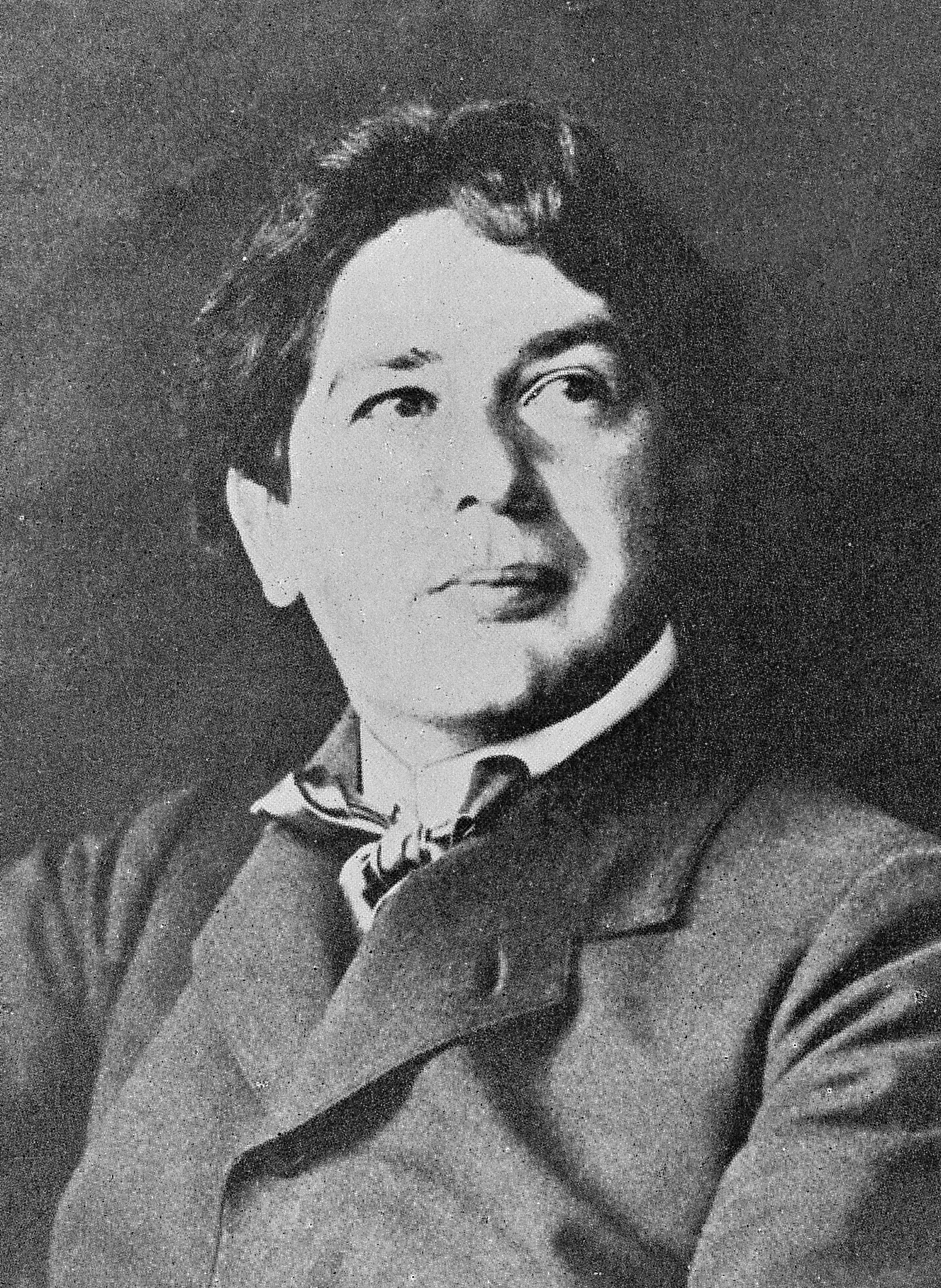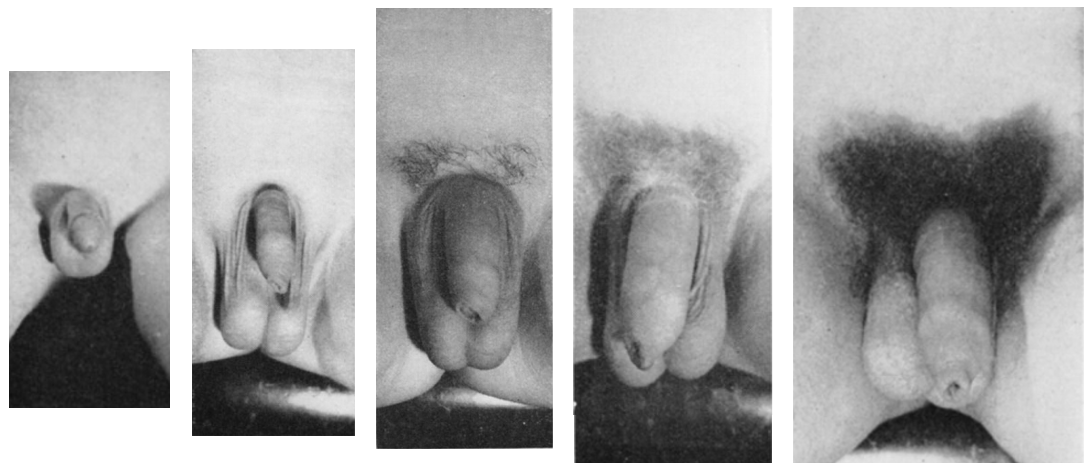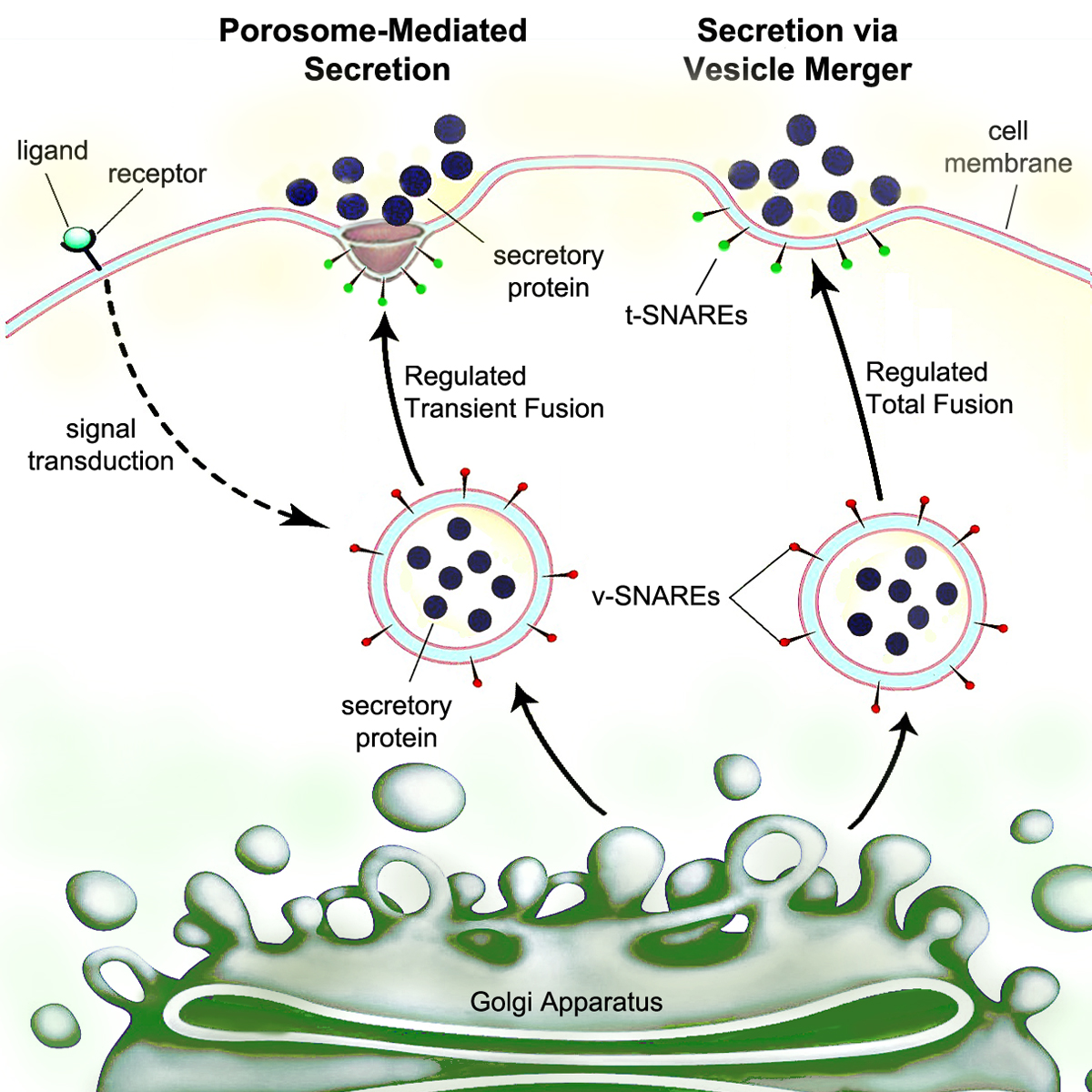|
Frölich's Syndrome
Adiposogenital dystrophy is a condition that may be caused by tertiary hypogonadism originating from decreased levels in GnRH. Low levels of GnRH has been associated with defects of the feeding centers of the hypothalamus, leading to an increased consumption of food and thus caloric intake. Presentation It is characterized by: * Obesity * Growth delays and delayed sexual development, atrophy or hypoplasia of the gonads, and altered secondary sex characteristics, * Headaches * Problems with vision * polyuria, polydipsia. It is usually associated with tumors of the hypothalamus, causing increased appetite and depressed secretion of gonadotropin. It seems to affect males mostly.Many overweight children may appear to have the disorder because of the concurrence of obesity and retarded sexual development; these children have no endocrine disturbances, however, and they mature normally after delayed puberty Puberty is the process of physical changes through which a child's bo ... [...More Info...] [...Related Items...] OR: [Wikipedia] [Google] [Baidu] |
Alfred Fröhlich
Alfred Fröhlich (August 15, 1871 – March 22, 1953) was an Austrian-American pharmacologist and neurologist born in Vienna. Biography Fröhlich was born in Vienna, into a Jewish family.Joseph Meites, ''Pioneers in Neuroendocrinology'', Springer Science & Business Media (2012), p. 115 In 1895 he graduated from the University of Vienna, afterwards remaining at Vienna as an assistant to Carl Nothnagel (1841–1905). In 1905 he became a member of the department of pharmacology at the university, and from 1919 until 1939 he was a full professor of pharmacology and toxicology. Following the Nazi takeover of Austria, Fröhlich emigrated to the United States, where he worked at the May Institute of Medical Research of the Jewish Hospital of Cincinnati. Here he continued his experimental research of the central nervous system. He is remembered for his studies on the effects of the pituitary on the autonomic nervous system. With Otto Loewi (1873–1961), he performed pharmacologica ... [...More Info...] [...Related Items...] OR: [Wikipedia] [Google] [Baidu] |
Polyuria
Polyuria () is excessive or an abnormally large production or Frequent urination, passage of urine (greater than 2.5 L or 3 L over 24 hours in adults). Increased production and passage of urine may also be termed as diuresis. Polyuria often appears in conjunction with polydipsia (increased thirst), though it is possible to have one without the other, and the latter may be a cause or an effect. Primary polydipsia may lead to polyuria. Polyuria is usually viewed as a symptom or Medical sign, sign of another Disease, disorder (not a disease by itself), but it can be classed as a disorder, at least when its underlying causes are not clear. Causes The most common cause of polyuria in both adults and children is uncontrolled diabetes mellitus, which causes osmotic diuresis; when glucose levels are so high that glycosuria, glucose is excreted in the urine. Water follows the glucose concentration passively, leading to abnormally high urine output. In the absence of diabetes mellitus, th ... [...More Info...] [...Related Items...] OR: [Wikipedia] [Google] [Baidu] |
Growth Disorders
Growth hormone therapy refers to the use of growth hormone (GH) as a prescription medication—it is one form of hormone therapy. Growth hormone is a peptide hormone secreted by the pituitary gland that stimulates growth and cell reproduction. In the past, growth hormone was extracted from human pituitary glands. Growth hormone is now produced by recombinant DNA technology and is prescribed for a variety of reasons. GH therapy has been a focus of social and ethical controversies for 50 years. This article describes the history of GH treatment and the current uses and risks arising from GH use. Other articles describe GH physiology, diseases of GH excess (acromegaly and pituitary gigantism), deficiency, the recent phenomenon of HGH controversies, growth hormone in sports, and growth hormone for cows. Medical uses HGH deficiency in children Growth hormone deficiency is treated by replacing growth hormone. Lonapegsomatropin was approved for medical use in the United State ... [...More Info...] [...Related Items...] OR: [Wikipedia] [Google] [Baidu] |
Puberty
Puberty is the process of physical changes through which a child's body matures into an adult body capable of sexual reproduction. It is initiated by hormonal signals from the brain to the gonads: the ovaries in a female, the testicles in a male. In response to the signals, the gonads produce hormones that stimulate libido and the growth, function, and transformation of the brain, bones, muscle, blood, skin, hair, breasts, and sex organs. Physical growth—height and weight—accelerates in the first half of puberty and is completed when an adult body has been developed. Before puberty, the external sex organs, known as primary sexual characteristics, are sex characteristics that distinguish males and females. Puberty leads to sexual dimorphism through the development of the secondary sex characteristics, which further distinguish the sexes. On average, females begin puberty at age 10½ and complete puberty at ages 15-17; males begin at ages 11½-12 and complete pube ... [...More Info...] [...Related Items...] OR: [Wikipedia] [Google] [Baidu] |
Endocrine
The endocrine system is a messenger system in an organism comprising feedback loops of hormones that are released by internal glands directly into the circulatory system and that target and regulate distant organs. In vertebrates, the hypothalamus is the neural control center for all endocrine systems. In humans, the major endocrine glands are the thyroid, parathyroid, pituitary, pineal, and adrenal glands, and the (male) testis and (female) ovaries. The hypothalamus, pancreas, and thymus also function as endocrine glands, among other functions. (The hypothalamus and pituitary glands are organs of the neuroendocrine system. One of the most important functions of the hypothalamusit is located in the brain adjacent to the pituitary glandis to link the endocrine system to the nervous system via the pituitary gland.) Other organs, such as the kidneys, also have roles within the endocrine system by secreting certain hormones. The study of the endocrine system and its disorde ... [...More Info...] [...Related Items...] OR: [Wikipedia] [Google] [Baidu] |
Male
Male (Planet symbols, symbol: ♂) is the sex of an organism that produces the gamete (sex cell) known as sperm, which fuses with the larger female gamete, or Egg cell, ovum, in the process of fertilisation. A male organism cannot sexual reproduction, reproduce sexually without access to at least one ovum from a female, but some organisms can reproduce both sexually and Asexual reproduction, asexually. Most male mammals, including male humans, have a Y chromosome, which codes for the production of larger amounts of testosterone to develop male reproductive organs. In humans, the word ''male'' can also be used to refer to gender, in the social sense of gender role or gender identity. Overview The existence of separate sexes has evolved independently at different times and in different lineage (evolution), lineages, an example of convergent evolution. The repeated pattern is sexual reproduction in isogamy, isogamous species with two or more mating types with gametes of identic ... [...More Info...] [...Related Items...] OR: [Wikipedia] [Google] [Baidu] |
Gonadotropin
Gonadotropins are glycoprotein hormones secreted by gonadotropic cells of the anterior pituitary of vertebrates. They are central to the complex endocrine system that regulates normal growth, sexual development, and reproductive function. The hormone family includes the mammalian hormones follicle-stimulating hormone (FSH) and luteinizing hormone (LH), the placental/ chorionic gonadotropins, human chorionic gonadotropin (hCG) and equine chorionic gonadotropin (eCG), as well as at least two forms of fish gonadotropins. LH and FSH are secreted by the anterior pituitary gland, while hCG and eCG are secreted by the placenta in pregnant women and mares, respectively. The gonadotropins act on the gonads, controlling gamete and sex hormone production. Gonadotropin is sometimes abbreviated ''Gn''. The alternative spelling ''gonadotrophin'' which inaccurately implies a nourishing mechanism is also used. There are various preparations of gonadotropins for therapeutic use, main ... [...More Info...] [...Related Items...] OR: [Wikipedia] [Google] [Baidu] |
Secretion
Secretion is the movement of material from one point to another, such as a secreted chemical substance from a cell or gland. In contrast, excretion is the removal of certain substances or waste products from a cell or organism. The classical mechanism of cell secretion is via secretory portals at the plasma membrane called porosomes. Porosomes are permanent cup-shaped lipoprotein structures embedded in the cell membrane, where secretory vesicles transiently dock and fuse to release intra-vesicular contents from the cell. Secretion in bacterial species means the transport or translocation of effector molecules. For example: proteins, enzymes or toxins (such as cholera toxin in pathogenic bacteria e.g. '' Vibrio cholerae'') from across the interior (cytoplasm or cytosol) of a bacterial cell to its exterior. Secretion is a very important mechanism in bacterial functioning and operation in their natural surrounding environment for adaptation and survival. In eukaryotic cells ... [...More Info...] [...Related Items...] OR: [Wikipedia] [Google] [Baidu] |
Appetite
Appetite is the desire to eat food items, usually due to hunger. Appealing foods can stimulate appetite even when hunger is absent, although appetite can be greatly reduced by satiety. Appetite exists in all higher life-forms, and serves to regulate adequate energy intake to maintain metabolic needs. It is regulated by a close interplay between the digestive tract, adipose tissue and the brain. Appetite has a relationship with every individual's behavior. Appetitive behaviour also known as approach behaviour, and consummatory behaviour, are the only processes that involve energy intake, whereas all other behaviours affect the release of energy. When stressed, appetite levels may increase and result in an increase of food intake. Decreased desire to eat is termed anorexia, while polyphagia (or "hyperphagia") is increased eating. Dysregulation of appetite contributes to ARFID, anorexia nervosa, bulimia nervosa, cachexia, overeating, and binge eating disorder. Role in disease ... [...More Info...] [...Related Items...] OR: [Wikipedia] [Google] [Baidu] |
Hypothalamus
The hypothalamus (: hypothalami; ) is a small part of the vertebrate brain that contains a number of nucleus (neuroanatomy), nuclei with a variety of functions. One of the most important functions is to link the nervous system to the endocrine system via the pituitary gland. The hypothalamus is located below the thalamus and is part of the limbic system. It forms the Basal (anatomy), basal part of the diencephalon. All vertebrate brains contain a hypothalamus. In humans, it is about the size of an Almond#Nut, almond. The hypothalamus has the function of regulating certain metabolic biological process, processes and other activities of the autonomic nervous system. It biosynthesis, synthesizes and secretes certain neurohormones, called releasing hormones or hypothalamic hormones, and these in turn stimulate or inhibit the secretion of hormones from the pituitary gland. The hypothalamus controls thermoregulation, body temperature, hunger (physiology), hunger, important aspects o ... [...More Info...] [...Related Items...] OR: [Wikipedia] [Google] [Baidu] |
Tumor
A neoplasm () is a type of abnormal and excessive growth of tissue. The process that occurs to form or produce a neoplasm is called neoplasia. The growth of a neoplasm is uncoordinated with that of the normal surrounding tissue, and persists in growing abnormally, even if the original trigger is removed. This abnormal growth usually forms a mass, which may be called a tumour or tumor.'' ICD-10 classifies neoplasms into four main groups: benign neoplasms, in situ neoplasms, malignant neoplasms, and neoplasms of uncertain or unknown behavior. Malignant neoplasms are also simply known as cancers and are the focus of oncology. Prior to the abnormal growth of tissue, such as neoplasia, cells often undergo an abnormal pattern of growth, such as metaplasia or dysplasia. However, metaplasia or dysplasia does not always progress to neoplasia and can occur in other conditions as well. The word neoplasm is from Ancient Greek 'new' and 'formation, creation'. Types A neopla ... [...More Info...] [...Related Items...] OR: [Wikipedia] [Google] [Baidu] |
Polydipsia
Polydipsia is excessive thirst or excess drinking.Porth, C. M. (1990). ''Pathophysiology: Concepts of altered health states''. Philadelphia: J.B. Lippincott Company. The word derives , which is derived . Polydipsia is a nonspecific symptom in various medical disorders. It also occurs as an abnormal behaviour in some non-human animals, such as in birds. Causes Diabetes Polydipsia can be characteristic of diabetes mellitus, often as an initial symptom. It is observed in cases of poorly controlled diabetes, which is sometimes the result of low patient adherence to anti-diabetic medication. Diabetes insipidus ("tasteless" diabetes, as opposed to diabetes mellitus) can also cause polydipsia. Other physiological causes It can also be caused by a change in the osmolality of the extracellular fluids of the body, hypokalemia, decreased blood volume (as occurs during major hemorrhage), and other conditions that create a water deficit. This is usually a result of osmotic diuresis. ... [...More Info...] [...Related Items...] OR: [Wikipedia] [Google] [Baidu] |





